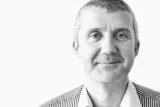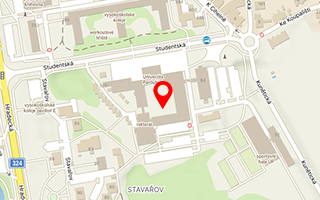Published: 23.06.2020
It was already at a primary school back in Slovakia that Filip Bureš fell for chemistry. He can recall in great detail all visits to the chemistry lab and the experiments done there. After his father let him have a small lab of his own in his company in Lanškroun, Czech Republic, he has stayed with the field up to now. Today, Professor Filip Bureš works at the Faculty of Chemical Technology, and together with his team develops new organic materials that may be used in areas such as electronics. What is needed is performance, precision and low energy consumption. In other words, the materials must work perfectly.
His research team works at the Institute of Organic Chemistry and Technology and deals with anything that has to do with carbon (and other elements). “What we want to achieve is that the organic molecules developed by us are of some use. Generally speaking, our focus is on organic electronics, which is a key field for today’s e-society,” says Professor Bureš.
Organic electronics includes things that all of us keep in our pockets or wear on our wrists; we can use them to produce light, transfer energy and they help us in a number of other activities. The research team of Professor Bureš deals with an active organic layer, which is invisible for users, but at the same time indispensable for the materials to work. “Just imagine a readable fast-response screen, multi colour low energy consumption diode, high-capacity miniature batteries, solar panels with high degree of light-to-energy conversion, fast and reversible molecular switches, sensors or detectors“ says Filip Bureš by way of example.
Our work is like working with LEGO
Today’s society places an enormous emphasis on electronic devices, their performance, low energy consumption and high and specific functions. Few people realize, however, that any improvement actually starts and finishes within the limits of the active layer studied by Professor Bureš since it is the layer that produces the effect in question. In a way, the research goes backwards.
“We have a desired function and material, and accordingly we choose an organic skeleton that we work with to achieve such a function,” explains Professor Bureš. “To make it simple, imagine a set of LEGO bricks. You have a lot bricks and it is up to you and your creativity what you want to build and what function, shape, size and form it will have. The “bricks” that we use are individual atoms that we are able to synthesize into molecules that are later modified and adjusted to achieve the desired effect and function“ says Bureš. The molecules they design and modify include organic push-pull molecules, optically active organic molecules or volatile inorganic-organic molecules.
Inspired by photosynthesis
The team also conducts intensive research into a new research field of photoredox catalysis, and has developed a simple catalyst to be used in photoredox catalysis, whose function is similar to that of chlorophyll. Will you remember how photosynthesis works?“Plants are able to transform carbon dioxide and water into sugar using chlorophyll. Plants are a sort of natural laboratory where organic synthesis takes place thanks to the light energy, “says Filip Bureš to explain the essence of photosynthesis He adds that thanks to photoredox catalysis organic chemists can conduct reactions under very mild reaction conditions.
“It is not necessary to apply heat to the reactions for an extended time; the reactions are only exposed to light in the presence of a little amount of the catalyst. In fact, the light energy directly transforms into chemical energy. In practice, you mix the ingredients, add the catalyst and put the flask at the window on a sunny day. Moreover, you can use flow arrangements, and thus continuously produce drugs and other important organic substances. For example, photoredox catalysis may enable us to get an immediate and permanent access to antimalarial drugs in Africa, which will be simple and cheap.”
The cooperation with the industry, both externally and internally, is thus key to the success. That is how we worked on the optimization of the catalyst synthesis and its pilot check. “We are able to synthesize the catalyst from cheap and available ingredients in multigram amounts, and we already have a commercial partner for its distribution. We will also apply for a European patent to protect the technology“ emphasizes Professor Filip Bureš.
Team work and hundreds of published papers
The team also requires effective collaboration to work. It took several years for the team to form. And Professor Bureš reaps the rewards for careful planning and thinking about who gets accepted to the team. His management philosophy is that of controlled creative freedom. He has experienced both strict discipline and enormous creative freedom during his international stays in Germany and Switzerland, and today combines these two approaches. “I see my role as a manager to be about responsibility and motivation. I also try to spark enthusiasm among my colleagues for the research area in question, and we try to work together to draw up a solid research project,“ says Professor Bureš to describe his role. What is more, the members of his research team are not merely colleagues, but rather friends, which he appeciates. “The whole team is excellent. I am only the team leader. Each member is responsible for his or her subfield, including any data measurements and interpretation, which also makes it easier to publish the results,” says Bureš.
The team has already published more than 100 papers in journals with impact factor. All papers are anchored in the field of organic chemistry, but they may be classified according to the type of the organic material, journal or involvement of other colleagues. Some members of the team are older than Professor Bureš, others are younger. And they learn from one another. His proudest moments as a teacher are those when his students brief him about a new area with erudition.
Filip Bureš believes there is a great potential in organic chemistry.“Even though we know more than 10 million organic molecules, there are millions yet to be discovered and used in practice. Hundreds of new students of chemistry are enrolled at the Faculty every year, and I believe that I will continue to be able to attract them to applied organic chemistry,“ says Filip Bureš.
“Chemistry is the only field which makes qualitative transformation of matter possible. A chemical reaction may transform one molecule into another, and thus create materials with new or better characteristics. That is something unique not available in other fields.“
Professor Filip Bureš (41) was born in Poprad, Slovakia. He completed his MA and PhD studies of Organic Chemistry at the Faculty of Chemical Technology of the University of Pardubice in 2002 and 2005 respectively, and he has worked at the Faculty since then. He did short internships in Hungary and Slovakia, completed a three-month stay in Germany and a 14-month postgraduate stay in Switzerland. In 2010 he qualified as associate professor and in 2017 he qualified as full professor. He is a member of the Czech Chemical Society. In 2012, he was awarded the Alfred Bader Chemistry Award as well as the Thieme Chemistry Award. Since 2004 he has authored or co-authored more than 100 papers with 1500 citations (H-index of 27). His current research interests cover advanced organic and organometallic materials with various applications. His team includes 23 members (10 members of academic staff, 4 PhD candidates, 4 MA and 5 BA students). More information about the team is available at bures.upce.cz. In addition to his university activities, he is also involved in the Secondary School Research Projects Competition. Filip Bureš, a father of two, is engaged and his hobbies include playing squash, jogging, travelling and DYI activities.


